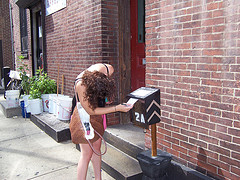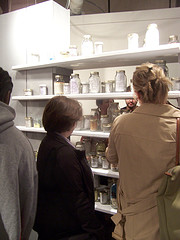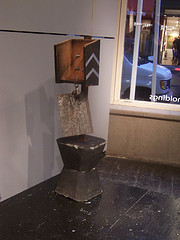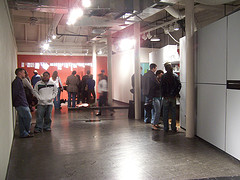While walking around Philadelphia this summer you may have noticed a small box on the street. On the top of it are instructions encouraging the deposit of a confession, anonymously, and the definition of confess: confess. v. to make oneself known; disclose one’s identity. The presence of this box may have seemed random, but actually it’s part of a three-fold project about the interactions of the city of Philadelphia, which culminated in the exhibit “Place Holdings” this month at 3rd Street Gallery.

Me, submitting my confession this past August
Interested in participating in the project, I hopped down to 1011 Arch St. last August with my sister, Kristin, to submit our confessions. We both scribbled a small note on a piece of paper, folded it, and stuffed it through the slot. I suddenly felt a little uncomfortable beside her – like there was some dark secret between us, something unsaid. Walking away, I broke the awkward silence by asking her what she had submitted. “I’m not telling you,” she replied.
The box in Chinatown that I visited is one of twelve that have been on the streets since June. The locations for the boxes were selected based on the original grid of Philadelphia by William Penn, rather than today’s map, in order to limit the size of the area involved in the project. The secrets were collected periodically by project members bicycling the city. Next, Michael Sebright, the project director, and his team devised a space to house the confessions, which would later become a stage for further artistic performances in September.

People sift through confessions, locked in clear glass mason jars
Each confession was documented and given an original number, and, after processing, placed into a clear glass mason jar. The confessions were then set onto a shelf built into an opening in the wall, which allowed a view of people on the other side, peek-a-boo style. Most of the confessions were anonymous, but there were a number of them bearing an author’s signature. The length and nature of the confessions varied greatly, from the more sordid guilty recount of a sexual encounter, to an empty cigarette carton and an angry note about the artist’s “arrogance” that he be worthy enough to receive a stranger’s confession. Anger recurred more than once at the “invasion of privacy;” one of the boxes, on 21st and Pine, was destroyed, with all of its contacts removed – Roberta and Libby and I spoke about how someone must have confessed something particularly awful or involving a worried outside party, and then wished to retract the information contained therein.
The word confession certainly has Catholic implications; disclosing one’s secrets to a priest will simultaneously expose them and admit that they were sins, thus alleviating the bearer of guilt. Yet the project doesn’t seem to have any overt religious implications, but rather explores the idea of sharing, in that two people must be involved for a confession to be complete. The action demands interaction – in order to be processed, a confession has to be stated by one party and received by another.

The destroyed confession box was at 339 Gallery (339 S 21st St.)
The submissions themselves raised questions about how comfortable people feel with the idea of privacy and brotherhood. The fact that they exist show that people want to communicate, and even the angry responses are the result of the desire to be heard. I know for myself that it was strangely satisfying to be able to confess to my misdeeds of the past, and comforting. Although my submission was anonymous, someone will read it and perhaps store its message, and thus a part of me, away in their memory.
The nature of the confessions evidence a wide emotional spectrum at the prompting for honesty and sharing, and Sebright made excellent use of the space in the gallery in building it to encourage interaction between people and the art. The visible hesitation of viewers in approaching the exhibit said much about the disconnect of the city itself, as it shows that even the art world is affected by a hesitation to relate and let down comfort barriers.

“Place Holdings” opened on First Friday of this month
The project will continue to expand until this Saturday, the 16th, on which day it will reach a level of stasis until it closes at the end of the month; no new confessions will be collected and the performances will end, but the exhibit will remain up. Look for information on these events on the website www.confess2.us. Also, I have more pictures from the First Friday opening on my flickr site.
“Place Holdings” is at 3rd Street Gallery on 2nd Street through October 1st. The exhibit will serve as a performance space and feature events nightly until the 16th, after the which it will remain open as an exhibit.
-Caitlin, the artblog intern.









